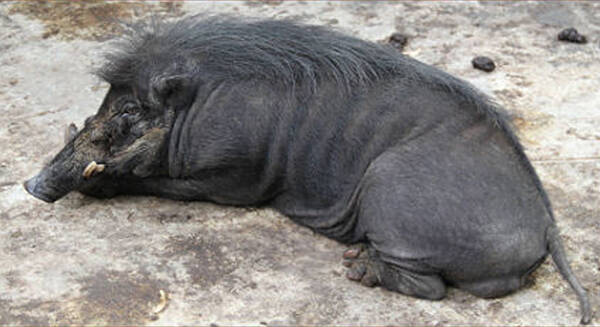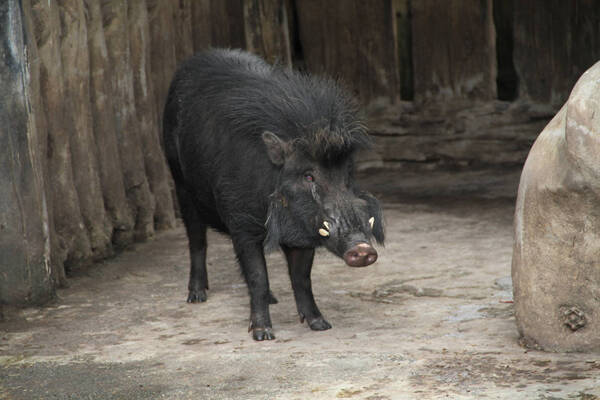Sus philippensis
IUCN
LCBasic Information
Scientific classification
- name:Sus philippensis
- Scientific Name:Sus philippensis,Philippine Warty Pig,Philippine warthog
- Outline:Ungulata
- Family:Artiodactyla Suidae Sus
Vital signs
- length:1.2-1.28m
- Weight:40-80kg
- lifetime:10-20years
Feature
Distribution and Habitat
The original range of the Philippine wild boar covered the islands west of the Philippines. This included Luzon, Biliran, Samar, Leyte, Mindoro, Mindanao, Jolo, Polillos, and Catanduanes, and possibly other islands in the archipelago.
It was once found in almost all habitats, abundant from sea level to altitudes of at least 2,800 m. As of 2005, the Philippine wild boar was common only in remote forests. It was reported to be common in mountainous and mossy forests at altitudes of 925-2,150 m in Balbalasang National Park, Kalinga Province, Philippines.
Appearance
The Philippine wild boar is a large wild boar, with a male body length of 1.28 meters and a female body length of 1.20 meters. The tail is about 14 centimeters long. The whole body is covered with coarse black hair, with some silver hair on the sides of the body. There is a ridge of long hair in the middle of the back, which is particularly obvious in males during the breeding season. There is a bristle on the head and neck. The tail is medium length with a tuft of long black hair at the tip.
The snout is long, forming a long pig snout, with a removable flat disk on the top and nostrils in the middle. The teeth are well developed. Large upper and lower canines protrude from the lower jaw, and the tusks are obvious defensive tools in males. The eyes and ears of boars are relatively small and narrow. There are four toes on the tip of the foot, but only the middle two toes are used for walking.
Details
Philippine Warty Pig (scientific name: Sus philippensis) has two subspecies.

Philippine Warty Pig is more active at night, but is also active during the day. It appears in pairs during the breeding season, usually forming small groups of 7-12. It is a generally timid and cautious animal that can defend itself vigorously when cornered, but can still be dangerous. Females are particularly defensive when protecting their young, and will attack potential predators, including humans, if they feel threatened.
The Philippine wild boar is an omnivorous species that feeds on a wide variety of foods. It feeds primarily on roots, leaves, tubers, grasses, and other plant material. It uses its long snout to plow the soil in search of food buried beneath the ground.
Philippine wild boar males are usually solitary, seeking out their mates only during the breeding season. After mating, females build nests in carefully selected areas. Typically, these nests are located between trees surrounded by dense undergrowth in the foothills. The average sow produces 4-5 piglets per litter. Up to 8 piglets can occur, but this is rare.

The Philippine wild boar is a species at risk of extinction. Since 2007, the species has been on the IUCN Red List in the Vulnerable category (VU). The species population is in severe decline. This decline is estimated to be more than 30% between three generational boundaries. The Philippine wild boar survives in most of the forested areas of the large islands of the Philippines. However, hunting and deforestation have led to the disappearance of large areas of its historical range and continue to threaten the remaining species population. High population growth and illegal deforestation to promote agriculture have also exacerbated these threats. There is also an increase in the incidence of crop damage caused by wild boars as they feed on corn, rice and cassava crops in farmlands, which has led to human hunting. Local farmers see them as legitimate targets for hunting and thus resist all local conservation measures. Another major threat to the Philippine wild boar is hybridization. Free-range domestic pigs have the ability to mate with the species and produce wild boars, threatening the integrity of the species.
The Philippine wild boar is a species protected under Philippine law. Unfortunately, these laws are rarely or not followed in some remote areas. In the larger Philippine islands, such as Luzon and Mindanao, wild boars are present in all major national parks, although most of these protected areas exist only on paper. Some of these national parks are known to be almost defoliated, and illegal logging and hunting continue in many other areas. In order to improve the status of this vulnerable species, programs to increase local awareness and change negative attitudes towards wild boars are recommended. Further research on its exact distribution, status and biology is also proposed, which will help formulate conservation measures and develop effective management plans to protect the remaining Philippine wild pig populations.
Listed in the IUCN Red List of Threatened Species in 2016 ver 3.1 - Vulnerable (VU).
Protect wildlife and eliminate game.
Maintaining ecological balance is everyone's responsibility!








